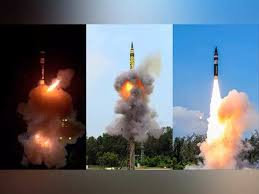India has more nukes than Pakistan, China far ahead: SIPRI report

New Delhi, June 17, 2025 —
India has now surpassed Pakistan in its nuclear arsenal, according to the latest findings of the Stockholm International Peace Research Institute (SIPRI). The 2025 SIPRI Yearbook reveals a subtle yet significant shift in South Asia’s nuclear balance, with India now possessing around 180 nuclear warheads, compared to Pakistan’s estimated 170. Meanwhile, China’s nuclear stockpile continues to surge, widening the strategic gap in the region.
This year’s SIPRI report underlines growing global concerns about the modernization and expansion of nuclear capabilities, especially in Asia. The think tank warns that this trend could exacerbate geopolitical tensions and increase the risk of conflict.
India’s Steady Nuclear Expansion
India’s nuclear policy, historically grounded in a doctrine of credible minimum deterrence, appears to be undergoing strategic evolution. With an estimated increase of eight warheads in the past year, India’s nuclear arsenal now stands at approximately 180.
SIPRI attributes this increase to continued modernization efforts, including the development and deployment of advanced delivery systems such as:
- Agni-V ICBM, capable of reaching targets over 5,000 km
- INS Arihant-class nuclear submarines, enhancing India’s sea-based deterrent
- Dhanush and Prithvi missiles, forming the tactical component of India’s nuclear triad
These developments reflect India’s focus on survivability and second-strike capability, both key elements of a credible deterrent posture in a region where strategic dynamics are increasingly volatile.
Pakistan: Matching Capability but Slower Growth
Pakistan, which has traditionally maintained a competitive edge in warhead numbers over India, now appears to be lagging slightly. Its stockpile is estimated to remain stable at around 170 warheads.
Though it continues to develop battlefield nuclear weapons and short-range systems like the Nasr (Hatf-IX) missile to counter India’s conventional superiority, the pace of Pakistan’s nuclear development appears to have slowed.
SIPRI notes that while Pakistan remains committed to expanding its arsenal, internal political instability, economic constraints, and international pressure may be tempering its nuclear ambitions.
China’s Rapid and Alarming Buildup
The most striking revelation of the SIPRI 2025 report is China’s dramatic rise in nuclear warheads. In just one year, Beijing has increased its stockpile from approximately 500 to 600 warheads—a staggering jump that signals its intentions to assert itself as a global nuclear power.
China is:
- Building over 300 new missile silos, many in Xinjiang and Inner Mongolia
- Deploying new road-mobile ICBMs like the DF-41, capable of carrying multiple warheads
- Expanding its sea-based deterrent with new Jin-class nuclear submarines
- Investing heavily in hypersonic glide vehicles (HGVs) and missile defense penetration capabilities
Analysts believe China may be aiming for nuclear parity with the United States and Russia, especially as tensions in the Taiwan Strait and South China Sea intensify.
Global Nuclear Landscape: A Shift Toward Modernization
SIPRI estimates the total number of nuclear warheads globally at 12,121, with around 9,614 of these in active military stockpiles. About 2,100 warheads are on high operational alert—mainly held by the U.S. and Russia.
The institute notes a clear trend: while the overall number of warheads continues to decline slowly, the number of operational warheads is increasing, and most nuclear powers are investing heavily in modernization programs.
This includes:
- The U.S. upgrading its B61 gravity bombs and developing the Sentinel ICBM
- Russia advancing its hypersonic Avangard missile and Poseidon underwater drone
- The UK and France maintaining steady but technologically advanced arsenals
South Asia’s Strategic Implications
The shift in nuclear balance between India and Pakistan has far-reaching implications. While the gap remains narrow, India’s edge—combined with its growing conventional superiority—may prompt Pakistan to further invest in tactical nuclear capabilities.
China’s rise as a nuclear power adds another layer of complexity to India’s strategic planning. With a widening gap between China’s and India’s arsenals, New Delhi may be compelled to reassess its minimum deterrence threshold.
Furthermore, the presence of three nuclear powers in Asia with overlapping security concerns—border tensions, regional rivalries, and shifting alliances—raises the specter of a potential arms race.
SIPRI’s Warning and Policy Recommendations
SIPRI’s report issues a stark warning: the world is entering a new era of nuclear competition. The organization urges global powers to:
- Resume arms control dialogues, especially between the U.S., Russia, and China
- Enhance transparency in nuclear doctrines and stockpiles
- Avoid aggressive posturing or deployments near conflict zones
- Support regional arms control frameworks in Asia
The report emphasizes that miscommunication or miscalculation in a tense environment like South Asia could have catastrophic consequences.
Conclusion
The 2025 SIPRI Yearbook paints a sobering picture of the global nuclear landscape, marked by increased stockpiles, ongoing modernization, and deteriorating arms control frameworks.
India’s slight lead over Pakistan in nuclear weapons may seem minor in numbers, but symbolically it reflects broader regional shifts. China’s rapid buildup, however, is reshaping strategic dynamics not just in Asia but globally.
As geopolitical rivalries deepen and military doctrines evolve, the international community faces an urgent task: reinvigorating diplomacy to avoid a new and dangerous nuclear age.






